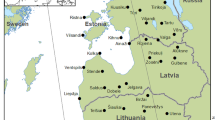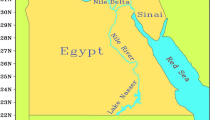Abstract
Studies have shown an increase in the frequency and severity of heat waves during the last decades under climate change. This study employs four temperature-based definitions, the percentile based TN90th—the 90th percentile of minimum temperature, and TX90th—the 90th percentile of maximum temperature, the Excess Heat Factor (EHF) and the Heat Wave Magnitude Index daily (HWMId), to investigate the present occurrence of heat waves (1981–2016) in five climatic zones of Nigeria. ERA-INTERIM reanalysis daily minimum and maximum temperature data were retrieved from ECMWF database for the purpose. Five characteristics were studied, the heat wave number, duration, frequency, amplitude and the magnitude. The study of heat wave characteristics in different climatic zones revealed that, from 1981 to 2016, heat waves occurred and covered more zones in the last decades. The first heat wave definitions (TN90, TX90 and EHF) revealed almost the same pattern of heat wave number (HWN) in Nigeria from 1981 to 2016 showing that of 1983, 1987, 1997, 2006 and 2007 where the latter had the highest number of events. The general coverage of the number of events increased from 1999. The Sahel was seriously affected by the highest number of events and the highest number of days for the duration and the frequency. The HWMId was used to quantify and compare the intensity of heat waves in the present time and revealed super extreme heat waves (HWMId > 32) in the Sahel and extreme heat waves in the south.











Similar content being viewed by others
References
Adeniyi M, Adeniyi MO, Oyekola SO (2017) Assessment of heat and cold wave events over West Africa using three regional climate models. Ann Geophys 60(3):A0322. https://doi.org/10.4401/ag-7039
Ajetomobi J (2015) Effect of weather extremes on crop yields with implications for crop insurance in Nigeria 61
Ajetomobi J (2016) Effects of weather extremes on crop yields in Nigeria. Afr J Food, Agric Nutr Dev 16(4):11168–11184. https://doi.org/10.18697/ajfand.76.15685
Akinsanola A, Ogunjobi K (2014) Analysis of rainfall and temperature variability Over Nigeria. Global J Hum-Soc Sci: B Geogr Geo-Sci 14(3):19
Alexander LV (2016) Global observed long-term changes in temperature and precipitation extremes: a review of progress and limitations in IPCC assessments and beyond. Weather Clim Extremes 11:4–16. https://doi.org/10.1016/j.wace.2015.10.007
Alexander LV, Zhang X, Peterson TC, Caesar J, Gleason B, Klein Tank AMG, Haylock M, Collins D, Trewin B, Rahimzadeh F, Tagipour A, Rupa Kumar A, Revadekar J, Griffiths G, Vincent L, Stephenson DB, Burn J, Aguilar E, Brunet M, Taylor M, New M, Zhai P, Rusticucci M, Vazquez-Aguirre JL (2006) Global observed changes in daily climate extremes of temperature and precipitation. J Geophys Res Atmos 111(5):22. https://doi.org/10.1029/2005JD006290
Ayanlade A, Radeny M, Morton JF, Muchaba T (2018) Rainfall variability and drought characteristics in two agro-climatic zones: an assessment of climate change challenges in Africa. Sci Total Environ 630:728–737. https://doi.org/10.1016/j.scitotenv.2018.02.196
Balogun R, Samson A, Ajayi V (2016) Investigation of heat wave characteristics over selected stations in Nigeria. J Geogr Environ Earth Sci Int 4(1):1–22. https://doi.org/10.9734/JGEESI/2016/18181
Barnabás B, Jäger K, Fehér A (2008) The effect of drought and heat stress on reproductive processes in cereals Plant. Cell Environ 31(1):11–38. https://doi.org/10.1111/j.1365-3040.2007.01727.x
CDC (2013) Climate change and extreme heat events. http://www.environ.ie/en/Environment/Atmosphere/ClimateChange/
Ceccherini G, Russo S, Ameztoy I, Marchese AF, Carmona-Moreno C (2016a) Heat waves in Africa 1981–2015, observations and reanalysis. Nat Haz Earth Syst Sci 1–17. https://doi.org/10.5194/nhess-2016-90
Ceccherini G, Russo S, Ameztoy I, Patricia CR, Carmona-Moreno C (2016b) Magnitude and frequency of heat and cold waves in recent decades: the case of South America. Nat Haz Earth Syst Sci 16:821–831. https://doi.org/10.5194/nhess-16-821-2016
Deo RC, Mcalpine CA, Syktus J, Mcgowan HA, Phinn S (2005) On Australian heat waves: time series analysis of extreme temperature events in, 626–635
Easterling DR, Evans JL, Groisman PY, Karl TR, Kunkel KE, Ambenje P (2000) Observed variability and trends in extreme climate events: a brief review. Bull Am Meteorol Soc 81(March):417–425. https://doi.org/10.1175/1520-0477
Giannini A (2007) Sahel drought and global climate change. Popul Environ Res Netw 1–3. https://doi.org/10.1029/2003GL018426
Horton RM, Mankin JS, Lesk C, Coffel E, Raymond C (2016) A review of recent advances in research on extreme heat events. Curr Clim Change Rep 2(4):242–259. https://doi.org/10.1007/s40641-016-0042-x
Hovmöller E (1949) The trough-and-ridge diagram. Tellus 1:62–66
Huth R, Kysely J, Pokorna L (2000) A GCM simulation of heat waves, dry spells, and their relationships to circulation. Clim Change 46(1–2):29–60. https://doi.org/10.1023/a:1005633925903
IPCC (2012) Managing the risks of extreme events and disasters to advance climate change adaptation. (Press CU, Cambridge U, New York U, NY, (eds).), Intergovernmental Panel on Climate Change. https://doi.org/10.1596/978-0-8213-8845-7
IPCC (2014) Climate Change 2014: Synthesis Report. Contribution of Working Groups I, II and III to the Fifth Assessment Report of the Intergovernmental Panel on Climate Change [Core Writing Team, Pachauri RK, Meyer LA (eds.)]. IPCC, Geneva, 151 pp
Jentsch A, Beierkuhnlein C (2008) Research frontiers in climate change: effects of extreme meteorological events on ecosystems. Comptes Rendus Geosci 340(9–10):621–628. https://doi.org/10.1016/j.crte.2008.07.002
Jiang Y, Huang B (2000) Effects of drought or heat stress alone and in combination on Kentucky bluegrass. Crop Sci 40(5):1358–1362. https://doi.org/10.2135/cropsci2000.4051358x
Jones PG, Thornton PK (2003) The potential impacts of climate change on maize production in Africa and Latin America in 2055. Glob Environ Change 13(1):51–59. https://doi.org/10.1016/S0959-3780(02)00090-0
Kendall MG (1975) Rank correlation methods, 4th edn. Charles Griffin, London
Le PV (2011) Climate change impacts on crop yields: reexamine evidence from decreasing diurnal temperature range. 1–49
Lobell WS, David B (2010) Robust negative impacts of climate change on African agriculture. Environ Res Lett 5(1):14010. https://doi.org/10.1088/1748-9326/5/1/014010
Lobell DB, Marianne B, Magorokosho C, Vivek B (2011) Nonlinear heat effects on African maize as evidenced by historical yield trials. Nat Clim Change 1(1):42–45. https://doi.org/10.1038/nclimate1043
Luo Q (2011) Temperature thresholds and crop production: a review. Clim Change 109(3–4):583–598. https://doi.org/10.1007/s10584-011-0028-6
Mann HB (1945) Non-parametric test against trend. Econometrica 13:245–259
Martius CS, Huw C, Davies (2006) A refined Hovmöller diagram. Tellus A: Dyn Meteorol Oceanogr 58:2, 221–226, https://doi.org/10.1111/j.1600-0870.2006.00172.x
Meehl GA, Karl T, Easterling DR, Changnon SA, Pielke RA et al (2000) An introduction to trends in extreme weather and climate events: observations, socioeconomic impacts, terrestrial ecological impacts, and model projections. Bull Am Meteorol Society 81(3):413–416
Muanya C, Anuforo E, Falaju J (2017) NIMET warns of more hot days, warm nights, heat waves. https://guardian.ng/news/nimet-warns-of-more-hot-days-warm-nights-heat-waves/
Nairn J, Fawcett R (2013) Defining heatwaves: heatwave defined as a heat-impact event servicing all community and business sectors in Australia, CAWCR technical report. https://doi.org/551.5250994
Nairn J, Fawcett R, Ray D (2009) Defining and predicting Excessive Heat events, a National system. Understanding high impact weather, CAWCR modelling workshop 83–86. Retrieved from http://scholar.google.com/scholar?hl=en&btnG=Search&q=intitle:Defining+and+predicting+Excessive+Heat+events+,+a+National+system#0
Nkrumah F, Ama N, Klutse B, Owusu K, Quagraine A, Adukpo DC (2011) Trends in daily extreme precipitation and temperature indices over Ghana from 1980 to 2011
NOAA National Weather Service (2015) Heat Index. Retrieved March 13, 2017, from http://www.srh.noaa.gov/jetstream/global/hi.html
Önöz B, Bayazit M (2003) The Power of Statistical Test for Trend Detection. Turk J Eng Environ Sci 27:247–251
Parmesan C, Root TL, Willig MR (2000) Impacts of extreme weather and climate on terrestrial biota. Bull Am Meteorol Soc 81(3):443–450. https://doi.org/10.1175/1520-0477(2000)081%3C0443
Perkins SE, Alexander LV (2013) On the measurement of heat waves. J Clim 26(13):4500–4517. https://doi.org/10.1175/JCLI-D-12-00383.1
Ragatoa DS, Ogunjobi KO, Okhimamhe AA, Francis SD, Adet L (2018a) A trend analysis of temperature in selected stations in nigeria using three different approaches. OALib 5(2):1–17. https://doi.org/10.4236/oalib.1104371
Ragatoa DS, Ogunjobi KO, Okhimamhe AA, Klutse NAB, Lamptey BL (2018b) Modeling earth systems and environment. A predictive study of heat wave characteristics and their spatio-temporal trends in climatic zones of Nigeria. Model Earth Syst Environ 4(3):1125–1151. https://doi.org/10.1007/s40808-018-0480-7
Reichstein M, Bahn M, Ciais P, Frank D, Mahecha MD, Seneviratne SI, Zscheischler J, Beer C, Frank CD, Papale N, Ramming D, Smith A, Kirsten P, Vicca T, Walz S, Wattenbach A, Wattenbach M, M (2013) Climate extremes and the carbon cycle. Nature 500(7462):287–295. https://doi.org/10.1038/nature12350
Russo S, Dosio A, Graversen RG, Sillmann J, Carrao H, Dunbar MB, Singleton A, Montagna P, Barbosa P, Vogt JV (2014) Magnitude of extreme heat waves in present climate and their projection in a warming world. J Geophys Res Atmos 119(22):12500–12512. https://doi.org/10.1002/2014JD022098
Russo S, Sillmann J, Fischer EM (2015) Top ten European heatwaves since 1950 and their occurence in the future. Environ Res Lett 10(12):124003. https://doi.org/10.1088/1748-9326/10/12/124003
Russo S, Marchese AF, Sillmann J, Immé G (2016) When will unusual heat waves become normal in a warming Africa? Environ Res Lett 11(5):054016. https://doi.org/10.1088/1748-9326/11/5/054016
Schmidt GA, Arndt D (2017) NOAA/NASA—annual global analysis for 2016
Sen PK (1968) Estimates of the regression coefficient based on Kendall’s Tau. J Am Stat Assoc 63:1379–1389
Singletaryab GW, Banisadr R, Keelingac PL (1994) Heat stress during grain filling in maize: effects on carbohydrate storage and metabolism. Aust J Plant Physiol 21:829–841. https://doi.org/10.1071/PP9940829
Sippel S, Otto FEL (2014) Beyond climatological extremes—assessing how the odds of hydrometeorological extreme events in South-East Europe change in a warming climate. Clim Change 125(3–4):381–398. https://doi.org/10.1007/s10584-014-1153-9
Sneyers R (1990) On the Statistical Analysis of Series of Observations. Technical Note No. 143, WMO No, 415. World Meteorological Organization, Geneva, 192 p
Soja A, Soja G (2003) Effects of weather conditions on agricultural crop production in Austria between 1869 and 2003 Witterungseinflüsse auf die landwirtschaftliche Pflanzenproduktion in Österreich zwischen 1869 und 2003, 58
Acknowledgements
The authors would like to thank the Federal University of Technology Minna (F.U.T Minna) for providing the appreciable support and infrastructure for the achievement of the analysis. This work has been supported by the Federal Ministry of Education and Research (BMBF) through the West African Science Service Centre on Climate Change and Adapted Land Use (WASCAL), our sincere thanks to BMBF and WASCAL. We thank also the European Centre for Medium-Range Weather Forecasts (ECMWF) for the data provided. The Expert Team on Sector-Specific Climate Indices (ET-SCI) ClimPACT project software was useful for this work and also the R-Statistic community that provides the packages used in the analysis like “extRemes”.
Author information
Authors and Affiliations
Corresponding author
Additional information
Publisher’s Note
Springer Nature remains neutral with regard to jurisdictional claims in published maps and institutional affiliations.
Rights and permissions
About this article
Cite this article
Ragatoa, D.S., Ogunjobi, K.O., Klutse, N.A.B. et al. A change comparison of heat wave aspects in climatic zones of Nigeria. Environ Earth Sci 78, 111 (2019). https://doi.org/10.1007/s12665-019-8112-8
Received:
Accepted:
Published:
DOI: https://doi.org/10.1007/s12665-019-8112-8




